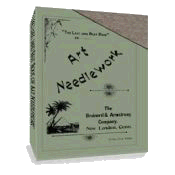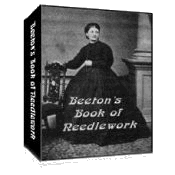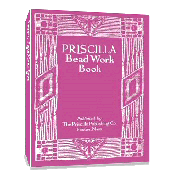Victorian Embroidery Frames
Embroidery frames are as necessary to most fine embroidery as the silks and needles used. Whether the frames are free standing, used on a table or held in the hand, they are indispensable to the embroiderer.
All the best kinds of embroidery, such as Church Embroidery, Crewel Work, Embroidery with silk, Tambour Work, and Berlin Work, require that their foundations shall be stretched in embroidery frames, as the stitches are apt to draw the material together when the work is embroidered in the hand, whereas the frame keeps the foundation evenly and tightly stretched in every part, and renders it almost impossible to pucker it, unless the Embroiderer is very unskillful.
Frames were (and still are) of two makes: the best are those upon stands, as their use prevents habits of stooping being acquired by the worker, leaves her hands free, and gives unimpeded access to the back part of the work, without the artificial aid of slanting the frame from the corner of some piece of furniture to her hands, or the holding that is necessary with the other kind. But as these stand frames are cumbersome and expensive, the smaller frame which could be held in the hand or leaned against a piece of furniture was most used.
In the late 1800’s, these frames were made of four equal sized pieces of wood (see Fig 1), or with the two horizontal pieces longer than the two upright, held together with nuts or pegs. They vary in size from 4 inches to 3 yards in length. The oblong embroidery frames are used for long and narrow pieces and the square for large pieces of work; and the same frame is used indifferently for Church Satin, and Crewel Embroideries, and for Berlin Work.




Tambour Frame
The frame for Tambour Work differs from the others. Tambour embroidery frames are what most of us call embroidery frames which we use for smaller embroidery projects. In the mid to late 1880’s, this type of frame was made of two circular wooden hoops, one smaller than the other (just like today’s common embroidery hoops). Both the hoops are covered with velvet cut on the cross and exactly fit one into the other. The material to be embroidered is fastened to the smaller hoop, and kept tight by the larger hoop being passed over it.
These tambours were not recommended by many embroiderers because the material was apt to stretch unevenly, and a worked part, if flattened between the hoops, was liable to be damaged.
The fastening of the material into the embroidery frame is called “dressing a frame,” and requires to be done with great nicety, as, if it is rucked, or unevenly pulled in any part, the advantage of the stretching is entirely destroyed.
Each material required its own special handling. Some could be stretched with minimal effort, others took two or more people to stretch properly and some even needed to be pasted to another type of material. Continue to
Part 2 - How Victorians Mounted Materials in Embroidery Frames for more information (and a few paste recipes, too!).
Return to top of page.
Return to Secrets of Embroidery page.



 433 pages!
433 pages!

